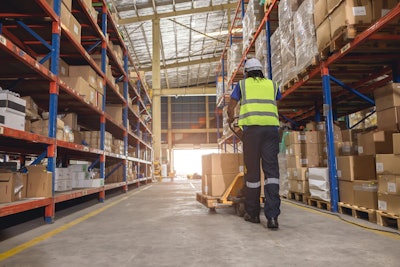In the complex world of logistics, warehouse consistency emerges as a pivotal factor, directly influencing crucial network metrics such as fill rate and on-time rate. All facilities consistently maintaining high-performance levels in these metrics drive success throughout the logistics network. Achieving high warehouse operations efficiency becomes paramount to meet the broader objectives of the complete supply chain. This article delves into the challenges faced in this quest, highlighting the crucial role of warehouse workers, the potential and challenges of automation, and the limitations of current Warehouse Management Systems (WMS).
The Burden on Warehouse Workers
In the age of next-day delivery pioneered by giants like Amazon, the expectations placed on warehouse staff have escalated dramatically. The demand for rapid fulfillment has become the norm, pushing all distribution sites relentlessly to expedite their order-to-delivery times. This relentless push for speed has fundamentally altered the landscape of warehouse operations.
Warehouse workers are now at the forefront of meeting these accelerated timelines. Their role in enhancing throughput – the efficiency with which orders are processed and dispatched – is more critical than ever. Achieving the required pace is not just about working faster; it involves a complex interplay of efficiency, accuracy and constant adaptation to changing operational demands.
In response to these heightened demands, a common approach might be to increase staffing levels. However, this solution is becoming increasingly unviable. Rising labor costs and a scarcity of available labor have made it difficult for many sites to simply "add more people." This scarcity is not just a logistical hurdle; it represents a fundamental shift in the way warehouses must operate. It emphasizes the need for more innovative solutions to meet throughput demands without relying solely on human labor. This shift highlights the urgency for support systems that not only complement but amplify the efforts of warehouse workers in this new era of logistics.
The Role of Automation in Enhancing Throughput
Automation emerges as a necessary ally to support warehouse workers. The benefits of automation are clear: it can significantly augment human capabilities, thereby contributing to better network metrics. For instance, automated guided vehicles (AGVs) and robots can transport goods within the warehouse, reducing the physical strain on workers and increasing speed. Automated sorting systems streamline the process of categorizing products, enhancing accuracy and efficiency. Moreover, advanced conveyor systems and robotic arms can expedite the packing and palletizing processes. However, the integration of automation is not without its challenges.
The complexities of robotic and human interactions demand a sophisticated level of orchestration. For example, collaborative robots (cobots) must be programmed to work alongside humans safely and efficiently, blending automated proficiency with human dexterity and decision-making skills. Because most sites are not able to go completely “dark” with 100% automation from stock to dock, automation systems must be designed to complement human efforts, not replace them, ensuring a seamless workflow. The key lies in finding the right balance where automation enhances efficiency without introducing new complexities. This integration of automation, ranging from simple conveyor belts to complex AI-driven robots, represents a significant step towards modernizing warehouse operations and meeting the escalating demands of next-day delivery.
Limitations of Current WMS Software and the Human Element
Unfortunately, the software we have in place to run warehouses is not set up to facilitate success. The current Warehouse Management Systems that are pivotal in managing warehouse operations often come with limitations as complexity is introduced to a site. While they offer functionalities addressing throughput and efficiency, like integrated scanning and directed work, they often fall short in optimizing processes considering labor, automation and space constraints. This shortfall impacts the warehouse's ability to balance business objectives effectively. These WMS limitations highlight a gap in these systems' ability to adapt to and manage the dynamic nature of warehouse operations, directly affecting network metrics and overall performance.
At the heart of warehouse operations is the human element - the decision-making prowess of those managing the floor. Effective decision-making is crucial, as poor decisions can lead to significant operational setbacks. These decisions are often based on a plethora of data, requiring a balance between human judgment and available technology. Making informed decisions quickly is essential in a fast-paced environment where every decision impacts the warehouse's efficiency and, consequently, network metrics. Ultimately, the difference between a high-performing site and a struggling one often hinges on the quality of these decisions. Regardless of the level of automation, it's the ability of the personnel to interpret data, anticipate challenges, and make strategic choices that define a site's success. Good decision-making can amplify the benefits of automation, turning a well-oiled machine into a powerhouse of efficiency and productivity. In contrast, poor decision-making can negate even the most advanced technological advantages.
The Future: A Need for Advanced Automation and Technology Integration
Given the limitations of current systems and the pressures on human workers, there is a clear need for more advanced automation and technology integration in warehouses. Such an orchestration platform can optimize a range of decisions and processes, alleviating the manual burden on staff and providing consistency across all operations in a network. By integrating advanced technology like artificial intelligence into their decision-making, warehouses can improve their efficiency and contribute significantly to achieving and surpassing desired network metrics. This integration represents the future of warehouse management, where technology and human effort work in harmony.
In summary, the drive for efficiency in warehouse operations hinges on a delicate balance between human efforts and automation. While the role of warehouse workers remains irreplaceable, the support of advanced automation and technology is indispensable. By integrating these elements effectively, warehouses can meet and exceed crucial network metrics, paving the way for success in the logistics network. Looking ahead, the evolution of warehouse management will likely see an even greater intertwining of technology and human expertise, setting new standards for efficiency and consistency in the logistics industry.





![Pros To Know 2026 [color]](https://img.sdcexec.com/mindful/acbm/workspaces/default/uploads/2025/08/prostoknow-2026-color.mduFvhpgMk.png?auto=format%2Ccompress&bg=fff&fill-color=fff&fit=fill&h=100&q=70&w=100)







![Pros To Know 2026 [color]](https://img.sdcexec.com/mindful/acbm/workspaces/default/uploads/2025/08/prostoknow-2026-color.mduFvhpgMk.png?ar=16%3A9&auto=format%2Ccompress&bg=fff&fill-color=fff&fit=fill&h=135&q=70&w=240)







